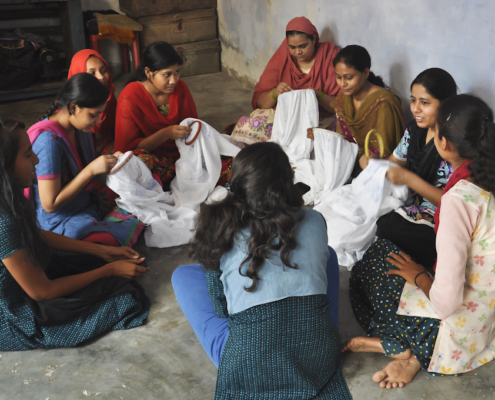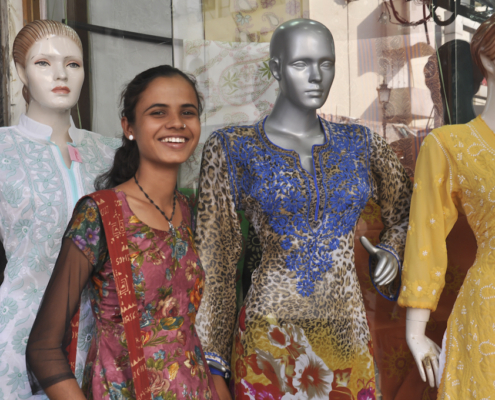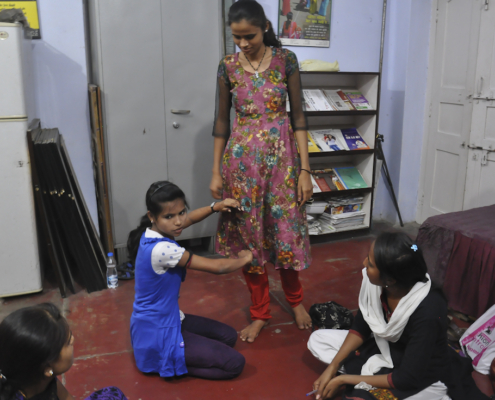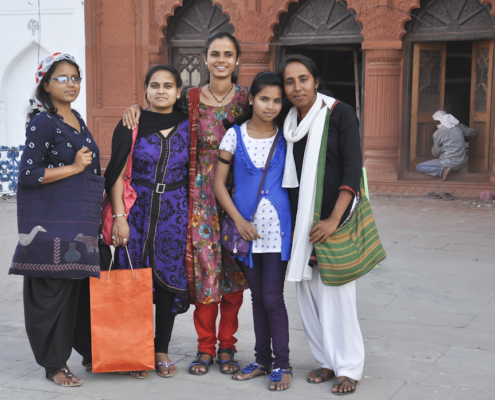Faradi to Lucknow
 Mohsin was my introduction to Lucknow. Grandson of a Shilpguru in chikan embroidery, he met us in Kanpur Central to make sure we got to Lucknow comfortably. He looks like Johnny Depp in his younger years, with amber eyes. But that was not it. He just took my heavy backpack from me without a second thought. My heart melted. Chivalry lives in Lucknow!
Mohsin was my introduction to Lucknow. Grandson of a Shilpguru in chikan embroidery, he met us in Kanpur Central to make sure we got to Lucknow comfortably. He looks like Johnny Depp in his younger years, with amber eyes. But that was not it. He just took my heavy backpack from me without a second thought. My heart melted. Chivalry lives in Lucknow!
Laxmi, Tulsi and Tara, three suf embroidery BMA graduates, Jaspal, an expert in chikan, and I boarded the train to Lucknow with Mohsin, to begin the second of our Artisan-to-Artisan outreach programs.
The concept of the program is to share the benefits of artisan education and begin to scale the Design Craft movement.
As with Bhujodi to Bagalkot, the Artisan Designer graduates will work one on one with artisans in a less exposed area- a sort of kick start to demonstrate that innovation in traditions, and design education can be beneficial. This gives the Artisan Designers an opportunity to expand their capacity by working as designers with artisans from other regions.
Practically focused, the program culminates in an exhibition sale. So, both groups will earn through sale of the products developed. The less exposed artisans will experience the potential of contemporary design and urban markets, and learn to take risks and benefit from venturing outside their current situation.
The overall goals of the program are to demonstrate that design is an effective and efficient means of insuring the sustainability of traditions, and to motivate artisans to consider design education.
The first two days we explored, trying to understand chikan embroidery and its current scenario. We began with Mohsin’s grandfather, Ayub Khan, perhaps an ironic icon. He is blind. He won the National Award for chikan embroidery and is a Shilp Guru. Dynamic and refreshingly forthright, he supervises a group of women embroiderers, mostly family members. But for him, chikan is a memory.
Chikan is different from most Kutch embroidery in many ways. First, it seems to be a courtly professional tradition, like the Mochi aari work that was patronized by royalty and elite in Kutch, rather than a folk art. Still, I tried to discover who are the original artisans, to go back as far as possible. Chikan has been commercial for so long that people have lost interest in history and meaning. The embroidery has become like bandhani work in Kutch- wage labor for women.
Ayub Khan says the traditional artisans are from just five kandans- one his own family. He says the origin was a traveling stranger who pulled threads from a fabric and showed someone how to embroider with them- like the fakir in the bandhani origin story.
So the thread and fabric were one, and chikan is traditionally white on white. Its beauty is texture. It is like a black and white photo- it forces you to see the content. I suspect that Ayub Khan can feel the quality of work and I hand him a suf stole. Yes, he knows this work, he says quickly. He has seen it in his travels.
We venture inside, where a group of women are ardently embroidering samples for a designer. The patterns are printed in bluing and the artisans hold the fabric taut with rings. Laxmi, Tulsi and Tara immediately connect, artisan-to-artisan, and start sharing personal and technical information.
 I ask one woman what she is embroidering?
I ask one woman what she is embroidering?
A kurta, she answers.
Have you ever seen the finished pieces?
She smiles wryly, no.
For me, it is hard to discern the quality of work done on the thick, sloppy blue lines. She seems to see these as guidelines, sometimes going to one side or the other. I ask, has she ever seen her own work after the fabric is washed?
Again, no.
So there is no ownership here, no connection to the work, really. It is just work. I ask her if she ever thinks of doing her own patterns? (Later I ask in the company of men, and one quickly answers “no, how could she? She just follows the pattern.”) But this woman says, “Of course!”
I ask if she ever thought of doing her own work?
Immediately she asks, “But where would I sell it?”
Quick and eager, the suf artisans conclude from their own interviews that there is a lot of interest in women doing their own designs. They have particularly identified two women. Next day, we return to talk to them. We have explained the project to Ayub Khan, and he says it is interesting. But when we ask the two women if they want to participate, he is bluntly discouraging. One woman hesitates, obviously torn. She wants to participate. But she is getting married in a few months. “Don’t lead them on,” Ayub Khan tells her. She knows her in-laws will not allow her to work. The other artisan, very young, is discouraged as well. One more name is suggested, to which Ayub Khan’s response is, she is without responsibilities, and too free. You cannot depend on her. Unfortunately, he was right.
Meanwhile, we meet a woman who does daraz, a wonderful applique joining technique which is almost forgotten. She has an eye condition that needs immediate attention, and her daughter is pregnant and suffering from severe, debilitating back pain. Another master artisan who shows us incredible work has no time and no interest in the project. Her son, who also embroiders, shows us an exquisite piece that he has framed. He wants to sell it, he says.
“NO!” we shout in unison. What would you have for inspiration? Make another one! He says he does not have a market. Superb workmanship and no market? What is wrong with this picture?
Then we meet Khushboo. She is staying with her mother, a shrewd, self-sufficient woman, in a tiny room with a tiny shop attached. Khushboo looks after the shop while her mother hears about the project, calling out periodically, “Mom! How much is this?” They like the project and when her mother relieves her and Khushboo comes back, she quickly bonds with the three suf artisans. Not just artisan-to-artisan, but young adult-to-young adult.
 Jaspal had short-listed these artisans. Lucknow has a mind-boggling work force. One point two lakhs! People tell us again and again. The first night in Lucknow, Jaspal organized a public presentation of the project at Sanatkada, an active not-for-profit organization founded and run by Madhavi. Madhavi has succeeded in bringing together a select group of people who care deeply about culture. Interesting, there is a clear sense that chikan is an important part of a shared, cherished culture. It is our “pehnava,” one woman explains. This contrasts with the distinctive community-specific embroidery styles of Kutch.
Jaspal had short-listed these artisans. Lucknow has a mind-boggling work force. One point two lakhs! People tell us again and again. The first night in Lucknow, Jaspal organized a public presentation of the project at Sanatkada, an active not-for-profit organization founded and run by Madhavi. Madhavi has succeeded in bringing together a select group of people who care deeply about culture. Interesting, there is a clear sense that chikan is an important part of a shared, cherished culture. It is our “pehnava,” one woman explains. This contrasts with the distinctive community-specific embroidery styles of Kutch.
There was concern in the group- will your project somehow dilute chikan? We assured them that the intent was to encourage artisans to innovate within their own tradition. And there was that concern about what will happen to the 1.2 lakhs of artisans whose lives depend on embroidery. I explained that it is not a question of abandoning markets. Neither do we need to create a market for chikan. You can put chikan in a dark room and it will sell. But the artisans could get more out of it.
The third day, we began the project. Madhavi generously opened the doors of her organization for the workshop. We waited to see who would show up. Khushboo was there, ready to go. A male artisan came, with another, older woman who was impressively knowledgeable about chikan. And Khushboo’s aunt and cousin arrived. By then, it was late morning. I introduced the project. Jaspal showed a presentation on chikan, and I showed one on suf. By then it was lunch time. By the time we organized that, it was too late to visit the museum. So we adjourned.
Day four, we waited again to see who would come.
And again I will call our partner artisans brave, to venture out of their comfort zones into the unknown. Women always face more challenges. We were told clearly that they have to obey their fathers, their brothers and their husbands. Not negotiable. So in the end, Khushboo and Manisha, two cousins, signed on. They are definitely courageous- as are their mothers.
We presented them with simple designing tool kits. Then we reviewed the presentations of the previous day, asking Khushboo and Manisha to identify the distinguishing characteristics of each tradition. Observation and analysis were new for them. We worked patiently. Colour was the main difference they saw. Finally they distinguished geometric and organic forms. Then Laxmi, Tulsi and Tara conducted a discussion of collections and costing, providing big picture planning for the October exhibition. They were excited, eager.
I asked Khushbhoo and Manisha to draw some chikan patterns. Manisha began immediately, finding quick, pure satisfaction in creating forms. Khushboo hesitated. I don’t know how to draw, she said. Mahendi was twining around her left arm. Who did that? I asked. She smiled. I gave her the pencil and permission, and she drew, enjoying it. The suf artisans led a discussion on garments, placement, layout and detailing. Then we all went to the bazaar to see contemporary chikan, and visited a pattern printer.
I was excited to purchase genuine chikan from the source, for friends and family. The amazing thing is that Lucknow is a sea of chikan. Everywhere you look there are chikan shops. Yet, when I asked where to find Good chikan, people all scratched their heads. They could only come up with the name of one shop! And in that sea I saw little design. The chief design concept seemed to be ‘fill it up’- all over patterning. I went back this time empty handed.
 The final day of our workshop began with an inspiration trip to Bada Imambara.
The final day of our workshop began with an inspiration trip to Bada Imambara.
Architecture, mahendi and chikan all express the same visual language. It is lyrical, floral and above all textural. On return, Khushboo and Manisha worked enthusiastically on layouts using this language. They dived in like the famed Lucknow fish into water. At the end of the day, they made embroidery sketches on hand-drawn patterns, with no hesitation at all. Laxmi commented that chikan is more time consuming than suf.
Someone at the Sanatkada program had stated that the oldest chikan was not printed but hand drawn. Printing patterns for repeat is an industrial concept, to make work faster, cheaper and more regular. Perfection was important in Nawabi architecture. But the natural forms on which the detailing is based are neither regular nor symmetrical. What if artisans could embroider like nature– or mahendi?
By the end of the day, Khushboo and Manisha had their plans for sampling clear, and were eager to start. We gave them fabric to begin. Laxmi, Tulsi and Tara were filled with their own ideas for the embroidery duets.
Finally, we all celebrated Laxmi’s birthday. I think it is one she will remember.
I am eager, too, to see what these artisans will create. And I think about the 1.2 lakhs of women whose livelihood depends on chikan. Are earning a living and getting satisfaction from your work mutually exclusive? If even some artisans can enjoy some of the excitement of Khushbhoo and Manisha would that not be good? And if unique, quality chikan could bring them better wages, would that not be even better? I dream of design education for these artisans too.
More to come.



